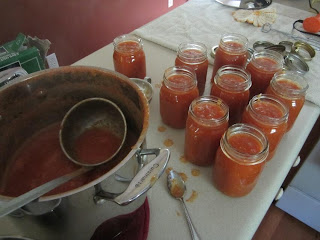This is the only recipe that my mom kept from all the years of canning she did when I was a girl. It is a family heirloom recipe that I am willing to share with readers because it is simple to make and very tasty!
When my family decided to quit dairy farming and move to town I was 8 years old. All of the canning supplies were sold at the farm auction and my mom didn't think twice about giving up that way of life. We were moving to a small lot that was mostly shaded and growing a garden wasn't feasible. Besides the lack of growing space in town, I recently asked my mom why she discontinued canning when moving off the farm because last year she decided to begin canning again after a 20 year break. Her response was quite simply this, "Canning food decades ago was a way of life for families living in the country. I didn't feel like I had a choice on whether to grow a large garden and preserve food. At that time it was to our financial advantage to grow and can our own food and there wasn't all of this hype about GMO's, pesticides, fertilizers, and food quality. Now that health is a concern nowadays, I feel it's important to know where our food comes from and how it's grown. Today it's not necessarily financially cheaper to grow and preserve food so it's more of a personal choice and lifestyle for most families." What an interesting perspective about how something like canning is "back in style" but for different reasons.
Tomato Soup:
1 peck tomatoes (12 pounds)
3 large onions
3 green bell peppers
small bunch of celery (~4 stalks)
dry mixture:
1 cup sugar
1 cup flour
scant 1/3 cup canning salt
Can and seal: pints 5 pounds for 10 minutes
Canning Tomato Soup
Posted by
Holly
on
Sunday, August 25, 2013
This is a personal preference, but I don't remove skins and seeds for this recipe because the tomatoes cook down enough where the skins are hardly noticeable and they are pulverized when the mixture is blended together. My family doesn't complain about the texture from the seeds. The added advantage of not removing seeds and skins is the amount of time that is saved!
I don't think I need to show every vegetable being chopped so basically chop everything in smallish chunks and place in large stainless soup pot.
Cook until everything is soft enough to blend. I use an immersion blender but you can use a food processor or blender. I definitely recommend the immersion blender because there is no transferring of the soup which means less dishes and a lot less mess. Believe me...this is one kitchen gadget you have to get. It's also useful for making applesauce!
Mix all of the dry ingredients together and add slowly to the soup mixture while mixing at the same time to prevent clumps. Obviously I couldn't take a picture while doing this because one hand is dumping and the other hand is mixing!
Place in sterilized jars: 10 narrow mouth jars per batch in the canner.
Process 5 pounds for 10 minutes.
I had 16 pounds of tomatoes which made 22 pints. The one jar in the lower right was a blue anniversary jar. I don't think the color is very appealing...kind of puke green.
And of course, remember to save your heirloom tomato seeds! In the small bowl in the picture above I have bleeding heart tomato seeds that I received from a gardener in his mid-80's who has spent decades perfecting the best tomato grown for this West Virginia region that is large, sweet, contains little water, and is disease resistant.
Here's Dad and me at the farm this past May. The farm is still in the family but the barn hasn't been used for a dairy operation since we moved 22 years ago. My Dad even suspects the leftover hay in the haymow was cut by him. Everything has been neglected and there are plans to have the Amish take it down and salvage the wood so this may be the last chance to see it standing. It was a bittersweet day visiting the farm: seeing the stanchions and water bowls, climbing the haymow, and envisioning my brother, sister, and I riding our bicycles in the barn while the cows were in pasture. When we leave a place there are always going to be good and bad memories. Thankfully I was young enough to remember the good times and think farm life was a lot of fun. But in actuality it was a lot of hard work for little profit. Like most small family farms in this country, it's nearly impossible to compete with larger farm operations without a second income.
Labels: Preservation , Recipes














0 comments :
Post a Comment